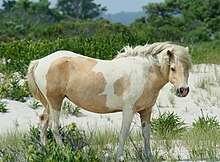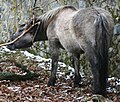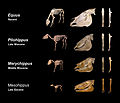
Back بوابة:خيول Arabic Portál:Koně Czech Portal:Pferdesport German Portal:Ecuestre Spanish Teemasivu:Hevoset Finnish Portail:Monde équestre French Portál:Lovas Hungarian Портал:Лошади Russian Portal:Hästsport Swedish
The Horses PortalThe horse (Equus ferus caballus) is a domesticated, one-toed, hoofed mammal. It belongs to the taxonomic family Equidae and is one of two extant subspecies of Equus ferus. The horse has evolved over the past 45 to 55 million years from a small multi-toed creature, close to Eohippus, into the large, single-toed animal of today. Humans began domesticating horses around 4000 BCE, and their domestication is believed to have been widespread by 3000 BCE. Horses in the subspecies caballus are domesticated, although some domesticated populations live in the wild as feral horses. These feral populations are not true wild horses, which are horses that never have been domesticated and historically linked to the megafauna category of species. There is an extensive, specialized vocabulary used to describe equine-related concepts, covering everything from anatomy to life stages, size, colors, markings, breeds, locomotion, and behavior. Horses are adapted to run, allowing them to quickly escape predators, and possess a good sense of balance and a strong fight-or-flight response. Related to this need to flee from predators in the wild is an unusual trait: horses are able to sleep both standing up and lying down, with younger horses tending to sleep significantly more than adults. Female horses, called mares, carry their young for approximately 11 months and a young horse, called a foal, can stand and run shortly following birth. Most domesticated horses begin training under a saddle or in a harness between the ages of two and four. They reach full adult development by age five, and have an average lifespan of between 25 and 30 years. Horse breeds are loosely divided into three categories based on general temperament: spirited "hot bloods" with speed and endurance; "cold bloods", such as draft horses and some ponies, suitable for slow, heavy work; and "warmbloods", developed from crosses between hot bloods and cold bloods, often focusing on creating breeds for specific riding purposes, particularly in Europe. There are more than 300 breeds of horse in the world today, developed for many different uses. (Full article...) Entries here consist of Good and Featured articles, which meet a core set of high editorial standards.
Garrett's Miss Pawhuska (1946–1975) was a Quarter Horse broodmare who produced eight foals, three of which would become world champion race horses. When she was a yearling, she was sold by her owner, although he had not really planned on selling her. He felt he had to because one of his employees had told a customer the filly was for sale. Garrett's Miss Pawhuska's official race record lists her with six wins in six starts, but it is incomplete and is missing some earnings as well as some races. After racing for two years, she retired to become a broodmare and died in 1975 at age 29. Her son Vandy's Flash was the first gelding to be named a World Champion Quarter Running Horse. She was inducted into the American Quarter Horse Association Hall of Fame. (Full article...)Selected image Close-up image of the quadriga (four-horse chariot) on top of the Brandenburg Gate in Berlin, Germany. The sculpture was produced by Johann Gottfried Schadow in 1793. Latest updates
More did you know?
Related portalsEntries here consist of Good and Featured articles, which meet a core set of high editorial standards.
The Chincoteague pony, also known as the Assateague horse, is a breed of horse that developed, and now lives, within a semi-feral or feral population on Assateague Island in the US states of Virginia and Maryland. The Chincoteague pony is one of the many breeds of feral horses in the United States. The breed was made famous by the Misty of Chincoteague novels, written by pony book author Marguerite Henry, and first published in 1947, and the pony Misty of Chincoteague. Although popularly known as Chincoteague ponies, the feral ponies live on Assateague Island. The entire island is owned by the federal government and is split by a fence at the Maryland/Virginia state line, with a herd of around 150 ponies living on the Virginia side of the fence, and 80 on the Maryland side. The herds live on land managed by two different federal agencies with very different management strategies. Ponies from the Maryland herd (referred to in the literature of the National Park Service as Assateague horses) live within Assateague Island National Seashore. They are generally treated as wild animals, given no more or less assistance than any other species on the island, other than contraceptive treatments to curb overpopulation. Conversely, the Virginia herd (referred to as Chincoteague ponies) lives within the Chincoteague National Wildlife Refuge, and is owned by the Chincoteague Volunteer Fire Company. The Virginia ponies are treated to twice-yearly veterinary inspections, which prepare them for life among the general equine population if they are sold at auction. While only around 300 feral ponies live on Assateague Island, around 1,000 more live off-island, having been purchased or bred by private breeders. (Full article...)Did you know (auto-generated)
General imagesThe following are images from various horse-related articles on Wikipedia.
TopicsHorse • Pony • Asinus • Equus (genus) • Equidae • Zebra • Glossary of equestrian terms • List of horse breeds • Evolution of the horse • Domestication of the horse • Horse care • Stable • Horse training • Equestrianism • Horse tack • Saddle • Equine nutrition • Equine anatomy • Equine conformation • Equine coat color • Equine coat color genetics • Horse markings • Equine vision • Horse hoof • Horseshoe • Horse gait • Horse behavior • Horse breeding • Breed registry • Equine infectious anemia • Horse colic • Lameness • Laminitis • Horse slaughter • Horses in warfare • Arabian horse • Thoroughbred SubcategoriesNew articlesThis list was generated from these rules. Questions and feedback are always welcome! The search is being run daily with the most recent ~14 days of results. Note: Some articles may not be relevant to this project.
Rules | Match log | Results page (for watching) | Last updated: 2024-08-24 20:21 (UTC) Note: The list display can now be customized by each user. See List display personalization for details.
WikiProjectsAssociated WikimediaThe following Wikimedia Foundation sister projects provide more on this subject:
Discover Wikipedia using portals |


























































